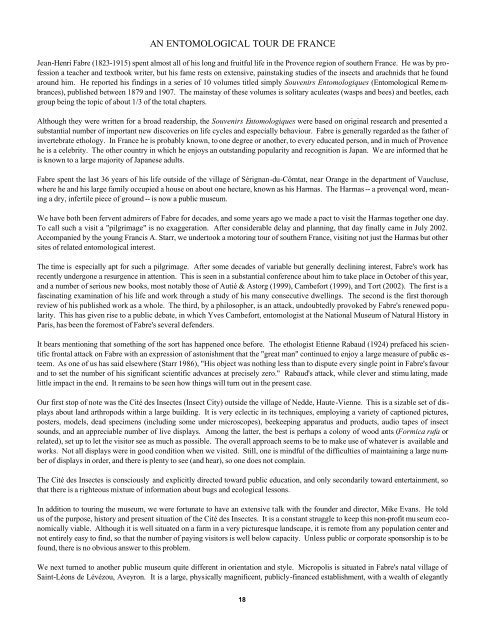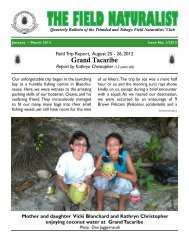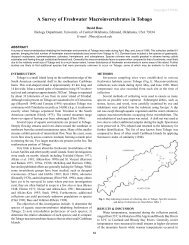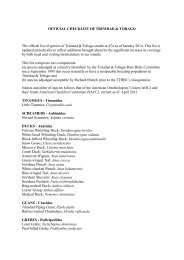Vol 2 - The Trinidad and Tobago Field Naturalists' Club
Vol 2 - The Trinidad and Tobago Field Naturalists' Club
Vol 2 - The Trinidad and Tobago Field Naturalists' Club
You also want an ePaper? Increase the reach of your titles
YUMPU automatically turns print PDFs into web optimized ePapers that Google loves.
AN ENTOMOLOGICAL TOUR DE FRANCEJean-Henri Fabre (1823-1915) spent almost all of his long <strong>and</strong> fruitful life in the Provence region of southern France. He was by professiona teacher <strong>and</strong> textbook writer, but his fame rests on extensive, painstaking studies of the insects <strong>and</strong> arachnids that he foundaround him. He reported his findings in a series of 10 volumes titled simply Souvenirs Entomologiques (Entomological Reme m-brances), published between 1879 <strong>and</strong> 1907. <strong>The</strong> mainstay of these volumes is solitary aculeates (wasps <strong>and</strong> bees) <strong>and</strong> beetles, eachgroup being the topic of about 1/3 of the total chapters.Although they were written for a broad readership, the Souvenirs Entomologiques were based on original research <strong>and</strong> presented asubstantial number of important new discoveries on life cycles <strong>and</strong> especially behaviour. Fabre is generally regarded as the father ofinvertebrate ethology. In France he is probably known, to one degree or another, to every educated person, <strong>and</strong> in much of Provencehe is a celebrity. <strong>The</strong> other country in which he enjoys an outst<strong>and</strong>ing popularity <strong>and</strong> recognition is Japan. We are informed that heis known to a large majority of Japanese adults.Fabre spent the last 36 years of his life outside of the village of Sérignan-du-Cômtat, near Orange in the department of Vaucluse,where he <strong>and</strong> his large family occupied a house on about one hectare, known as his Harmas. <strong>The</strong> Harmas -- a provençal word, meaninga dry, infertile piece of ground -- is now a public museum.We have both been fervent admirers of Fabre for decades, <strong>and</strong> some years ago we made a pact to visit the Harmas together one day.To call such a visit a "pilgrimage" is no exaggeration. After considerable delay <strong>and</strong> planning, that day finally came in July 2002.Accompanied by the young Francis A. Starr, we undertook a motoring tour of southern France, visiting not just the Harmas but othersites of related entomological interest.<strong>The</strong> time is especially apt for such a pilgrimage. After some decades of variable but generally declining interest, Fabre's work hasrecently undergone a resurgence in attention. This is seen in a substantial conference about him to take place in October of this year,<strong>and</strong> a number of serious new books, most notably those of Autié & Astorg (1999), Cambefort (1999), <strong>and</strong> Tort (2002). <strong>The</strong> first is afascinating examination of his life <strong>and</strong> work through a study of his many consecutive dwellings. <strong>The</strong> second is the first thoroughreview of his published work as a whole. <strong>The</strong> third, by a philosopher, is an attack, undoubtedly provoked by Fabre's renewed popularity.This has given rise to a public debate, in which Yves Cambefort, entomologist at the National Museum of Natural History inParis, has been the foremost of Fabre's several defenders.It bears mentioning that something of the sort has happened once before. <strong>The</strong> ethologist Etienne Rabaud (1924) prefaced his scientificfrontal attack on Fabre with an expression of astonishment that the "great man" continued to enjoy a large measure of public esteem.As one of us has said elsewhere (Starr 1986), "His object was nothing less than to dispute every single point in Fabre's favour<strong>and</strong> to set the number of his significant scientific advances at precisely zero." Rabaud's attack, while clever <strong>and</strong> stimu lating, madelittle impact in the end. It remains to be seen how things will turn out in the present case.Our first stop of note was the Cité des Insectes (Insect City) outside the village of Nedde, Haute-Vienne. This is a sizable set of displaysabout l<strong>and</strong> arthropods within a large building. It is very eclectic in its techniques, employing a variety of captioned pictures,posters, models, dead specimens (including some under microscopes), beekeeping apparatus <strong>and</strong> products, audio tapes of insectsounds, <strong>and</strong> an appreciable number of live displays. Among the latter, the best is perhaps a colony of wood ants (Formica rufa orrelated), set up to let the visitor see as much as possible. <strong>The</strong> overall approach seems to be to make use of whatever is available <strong>and</strong>works. Not all displays were in good condition when we visited. Still, one is mindful of the difficulties of maintaining a large numberof displays in order, <strong>and</strong> there is plenty to see (<strong>and</strong> hear), so one does not complain.<strong>The</strong> Cité des Insectes is consciously <strong>and</strong> explicitly directed toward public education, <strong>and</strong> only secondarily toward entertainment, sothat there is a righteous mixture of information about bugs <strong>and</strong> ecological lessons.In addition to touring the museum, we were fortunate to have an extensive talk with the founder <strong>and</strong> director, Mike Evans. He toldus of the purpose, history <strong>and</strong> present situation of the Cité des Insectes. It is a constant struggle to keep this non-profit mu seum economicallyviable. Although it is well situated on a farm in a very picturesque l<strong>and</strong>scape, it is remote from any population center <strong>and</strong>not entirely easy to find, so that the number of paying visitors is well below capacity. Unless public or corporate sponsorship is to befound, there is no obvious answer to this problem.We next turned to another public museum quite different in orientation <strong>and</strong> style. Micropolis is situated in Fabre's natal village ofSaint-Léons de Lévézou, Aveyron. It is a large, physically magnificent, publicly-financed establishment, with a wealth of elegantly18








